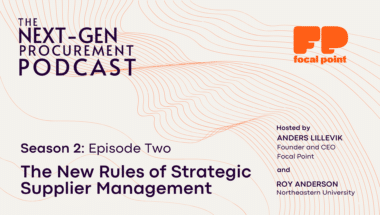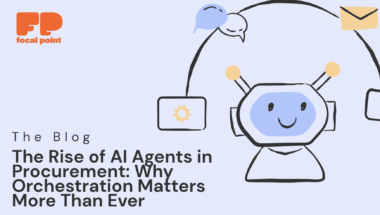The following insights are share from a joint webinar with SIG to discuss the future of procurement orchestration, featuring President & CEO Dawn Tiura, Focal Point’s Anders Lillevik and Matthew Buckingham.You can listen to their conversation here.
What is Procurement Orchestration Today?
Procurement orchestration is more than just a trendy term; it’s a comprehensive approach to managing the procurement process from start to finish. As Anders explained, while intake orchestration focuses on funneling work into procurement, procurement orchestration covers the entire journey—from the initial request to contract and payment. Traditionally, procurement involved manual, often disjointed processes. However, with modern tools and solutions, we can now streamline these processes, making them more efficient and user-friendly.
Today, procurement orchestration involves coordinating various activities such as onboarding suppliers, conducting financial stability assessments, and ensuring compliance with internal policies and external regulations. This orchestration ensures that all necessary steps are taken to move from an initial procurement request to the final payment efficiently. The use of data-driven workflows and integration with third-party data sources has significantly enhanced the capability of procurement teams to manage these processes effectively.
One key aspect of current procurement orchestration is the ability to automate repetitive tasks. For instance, setting up workflows that trigger specific actions when certain conditions are met, such as initiating a risk assessment when a new supplier is onboarded, helps reduce manual intervention and speeds up the entire process. This automation is crucial in eliminating bottlenecks and ensuring that procurement activities are completed on time and within budget.
What Will Procurement Orchestration Become?
The future of procurement orchestration is promising. The industry is moving towards more integrated and intelligent systems. These systems will not only handle transactions but also manage suppliers, assess third-party risks, and develop category strategies. Anders and Matthew highlighted the potential for orchestration tools to aggregate and enrich data from various sources, enabling more informed decision-making. This evolution is expected to bring about more automation, reducing the need for manual intervention and allowing procurement professionals to focus on strategic tasks.
In the coming years, we can expect procurement orchestration to become more predictive and proactive. Advanced analytics and AI will play a significant role in this transformation. By analyzing historical data and identifying patterns, these technologies can provide insights into future procurement needs and potential risks. For example, AI-driven analytics can predict price fluctuations in certain categories, allowing procurement teams to make more informed decisions about when to purchase goods and services.
Moreover, the integration of AI with procurement orchestration tools will enable more personalized and context-aware workflows. These systems will be able to tailor processes based on the specific needs and preferences of different users, enhancing the overall efficiency and effectiveness of procurement activities. Additionally, the use of natural language processing (NLP) and machine learning (ML) will facilitate better contract management by automatically extracting and analyzing key terms and clauses from contracts.
Where Are the Blind Spots in Today’s Orchestration Processes?
Despite the advancements, there are still blind spots in current orchestration processes. One major issue identified is the overemphasis on transactional procurement while neglecting other critical areas like supplier management and risk assessment.
Additionally, many orchestration solutions are tailored to specific providers, limiting their applicability across different procurement needs. The lack of comprehensive orchestration tools often forces companies to rely on outdated methods, such as Excel or SharePoint, to manage contracts and policies, which can lead to inefficiencies and errors.
Another blind spot is the lack of integration with existing systems and data sources.
Many organizations have multiple disparate systems for managing different aspects of procurement, such as ERP systems, contract management systems, and supplier management systems. Without seamless integration, it becomes challenging to get a holistic view of procurement activities and make data-driven decisions. This fragmentation also leads to duplication of efforts and increased risk of errors.
Additionally, there’s often a gap in user adoption and training. Even the most advanced orchestration tools can fail to deliver value if users are not adequately trained to use them effectively. Ensuring that procurement professionals are comfortable and proficient with these tools is essential for maximizing their benefits.
How Can We Address These Blind Spots?
To address these blind spots, it’s crucial to adopt a holistic approach to procurement orchestration. Here are some strategies discussed by our panel:
- Data Integration and Enrichment: Implementing systems that can aggregate data from multiple sources and enrich it with third-party information will provide a more complete picture of procurement activities. This integration should encompass ERP systems, contract management systems, supplier databases, and any other relevant data sources. By creating a centralized data repository, procurement teams can access all necessary information in one place, making it easier to analyze and act upon.
- Flexible Workflow Management: Developing conditionally and contextually driven workflows can ensure that procurement processes are tailored to the specific needs of different organizations. These workflows should be adaptable to changes in business requirements and regulatory environments. By using AI and machine learning, these workflows can also become more intelligent, automatically adjusting based on real-time data and insights.
- Enhanced Analytics and Recommendations: Leveraging AI to analyze data and provide actionable insights can help procurement teams make better decisions and improve forecasting. Predictive analytics can identify potential risks and opportunities, enabling procurement professionals to proactively address issues before they escalate. Additionally, AI-driven recommendations can suggest best practices and optimization strategies, helping teams to continuously improve their processes.
- Collaboration with Solution Providers: Engaging with technology providers to develop tools that address the specific challenges faced by procurement professionals will lead to more effective and comprehensive orchestration solutions. This collaboration should involve regular feedback and updates to ensure that the tools remain relevant and effective in addressing evolving procurement needs.
- User Training and Adoption: Ensuring that procurement professionals are well-trained and comfortable with using orchestration tools is crucial for their successful implementation. Providing comprehensive training programs, ongoing support, and easy-to-use interfaces can help increase user adoption and maximize the benefits of these tools.
Conclusion
By addressing the current blind spots and leveraging advanced technologies, we can create more efficient, strategic, and proactive procurement processes. At Focal Point, we’re committed to helping procurement teams navigate this evolving landscape and achieve greater success. You can learn more about Focal Point or schedule a demo today!



